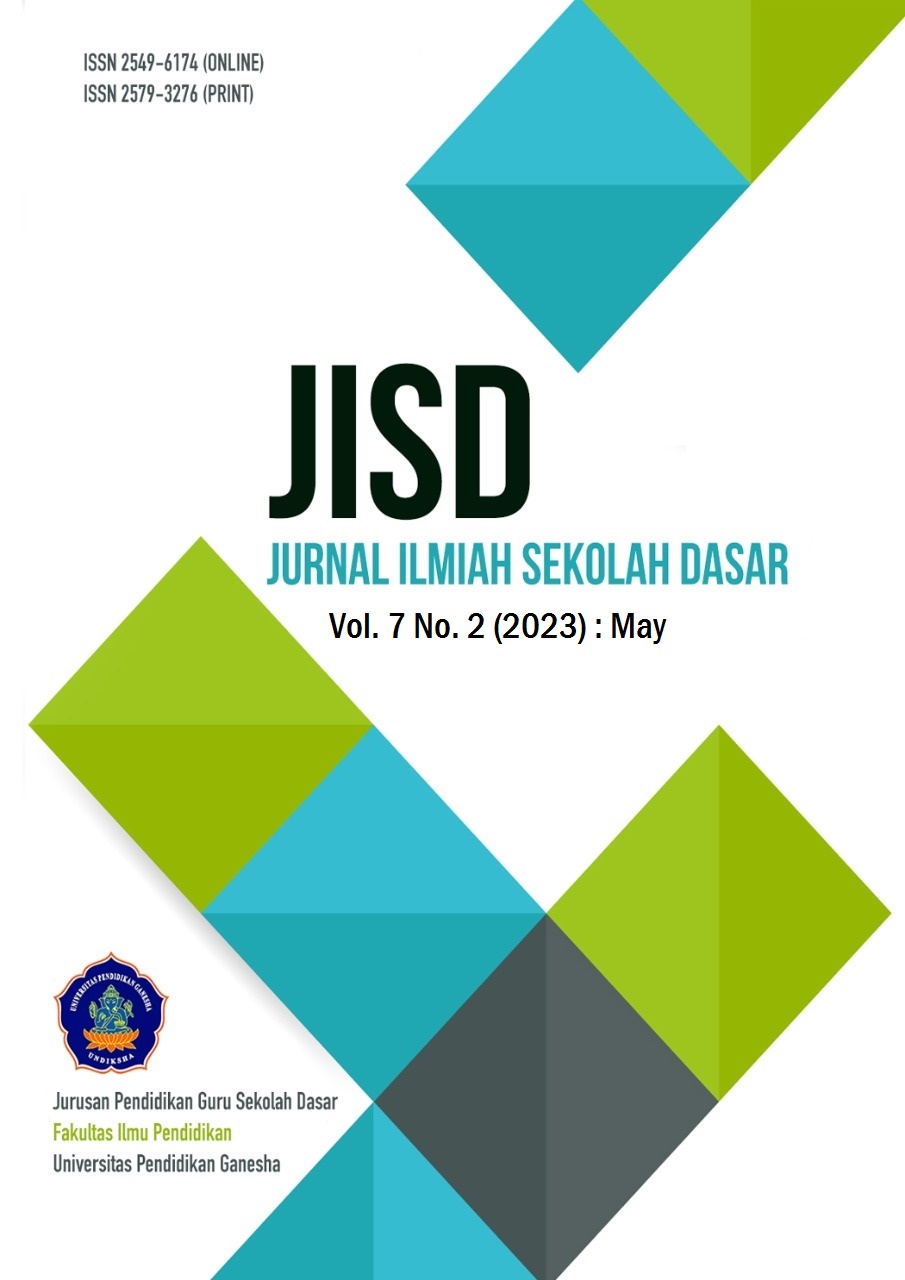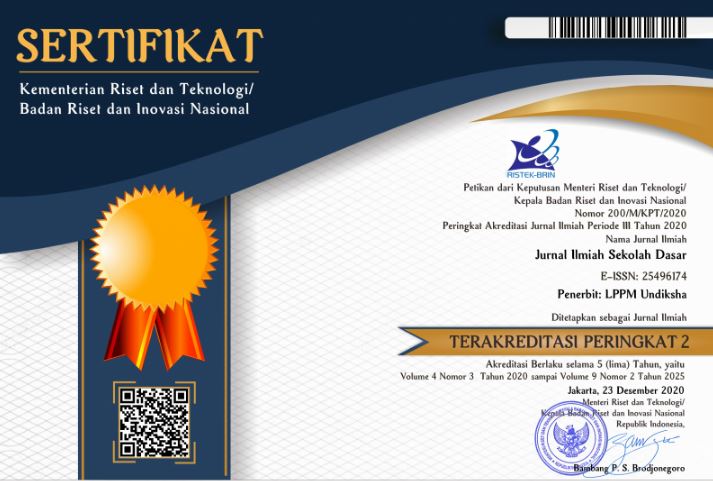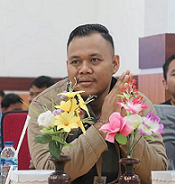Science Teaching Materials Based on Multiple Intelligences
DOI:
https://doi.org/10.23887/jisd.v7i2.53989Keywords:
Developing, Teaching Materials, Multiple IntellegencesAbstract
The problem in this research is that there need to be science teaching materials based on multiple intelligences and low science learning outcomes. This study aims to produce appropriate multiple intelligences-based science teaching materials and know the effectiveness of science teaching materials based on multiple intelligences. This type of research is development research which refers to the ADDIE development model. Methods of data collection using a questionnaire. The research instrument used was a questionnaire in the form of validity and practicality sheets; the validation sheet was filled in by material experts, learning design experts, and teachers, while fourth-grade students carried out the student effectiveness test. The data collected from the questionnaire results were analyzed using quantitative description analysis techniques. The results showed that the material expert validation included the very feasible category of 89.67%. The validation of category learning design experts is very feasible, 91%. The teacher validation results are in the proper category at 79.20%. Based on the results of limited trials of multi-intelligence-based science teaching materials, teachers and students believe it is suitable for use in class IV and for independent learning. It was concluded that science teaching materials based on multiple intelligences were appropriate for learning.
References
Abidin, Z. (2017). Pengembangan kecerdasan majemuk (multiple intelligences) di madrasah. Elementary: Jurnal Iilmiah Pendidikan Dasar, 3(2), 120–131. https://e-journal.metrouniv.ac.id/index.php/elementary/article/view/832. DOI: https://doi.org/10.32332/elementary.v3i2.832
Acesta, A., Sumantri, & Fahrurrozi. (2020). Developing multiple intelligence-based natural science learning module to improve elementary school students’ higher order thinking skills. Indonesian Journal of Learning and Instruction, 3(2), 111–118. https://doi.org/10.25134/ijli.v3i2.3681.
Adijaya, M. A., Widiana, I. W., Parwata, I. G. L. A., & Antara, I. G. W. S. (2023). Bloom’s Taxonomy Revision-Oriented Learning Activities to Improve Procedural Capabilities and Learning Outcomes. International Journal of Educational Methodology, 9(1), 261–270. https://doi.org/10.12973/ijem.9.1.261. DOI: https://doi.org/10.12973/ijem.9.1.261
Akkuzu, N., & Akçay, H. (2011). Procedia Computer The design of a learning environment based on the theory of multiple intelligence and the study its effectiveness on the achievements , attitudes and retention of students. Procedia Computer Science, 3, 1003–1008. https://doi.org/10.1016/j.procs.2010.12.165. DOI: https://doi.org/10.1016/j.procs.2010.12.165
Al-Qatawneh, S. S., Alsalhi, N. R., Eltahir, M. E., & Siddig, O. A. (2021). The representation of multiple intelligences in an intermediate Arabic-language textbook, and teachers’ awareness of them in Jordanian schools. Heliyon, 7(5), e07004. https://doi.org/10.1016/j.heliyon.2021.e07004. DOI: https://doi.org/10.1016/j.heliyon.2021.e07004
Amir, F. A. (2020). Pengembangan Bahan Ajar Panca Indera Berbasis Multiple Intelligences Pada Siswa Kelas I Sekolah Dasar. Pedagogik Journal of Islamic Elementary School, 3(1), 105–118. https://doi.org/10.24256/pijies.v3i1.1141. DOI: https://doi.org/10.24256/pijies.v3i1.1141
Ayesha, B., & Khurshid, F. (2013). The Relationship of Multiple Intelligence and Effective Study Skills with Academic Achievement Among University Students. Global Journal of Human Social Science Linguistics and Education, 13(1), 22.
Branch, R. M., & Dousay, T. A. (2015). Survey of instructional design models (Donovan R. Walling (ed.)). Printed in the United States of America.
Charles M. Reigeluth. (1999). Intructional-Design Theories And Models A New Paradgm of Instructional Theory. Routledge.
Díaz-Posada, L. E., Varela-Londoño, S. P., & Rodríguez-Burgos, L. P. (2017). Inteligencias múltiples e implementación del currículo: Avances, tendencias y oportunidades. Revista de Psicodidactica, 22(1), 69–83. https://doi.org/10.1387/RevPsicodidact.15614. DOI: https://doi.org/10.1016/S1136-1034(17)30046-1
Ferrero, M., Vadillo, M. A., & León, S. P. (2021). A valid evaluation of the theory of multiple intelligences is not yet possible: Problems of methodological quality for intervention studies. Intelligence, 88. https://doi.org/10.1016/j.intell.2021.101566. DOI: https://doi.org/10.1016/j.intell.2021.101566
Fitria, Y., & Idriyeni, I. (2017). Development of Problem-Based Teaching Materials for The Fifth Graders of Primary School. Jurnal Ta’dib, 20(2), 99–106. https://doi.org/http://dx.doi.org/10.31958/jt.v20i2.747. DOI: https://doi.org/10.31958/jt.v20i2.747
Gani, A. A. (2016). InovasiPembelajaran Ilmu Pengetahuan Alam Berbasis Potensi Alam menyikapi Era MEA. Jurnal Pembelajaran Fisika, 4(5), 754–767. https://jurnal.unej.ac.id/index.php/JPF/article/view/3721.
Gardner, H., & Hatch, T. (1989). Educational implications of the theory of multiple intelligences. Educational Researcher, 18(8), 4–10. https://doi.org/10.3102%2F0013189X018008004. DOI: https://doi.org/10.3102/0013189X018008004
Hermita, N. (2017). Pembelajaran Berbasis Kecerdasan Jamak di SD. Deep Publish.
Indria, A. (2020). Multiple Intellegences. Jurnal Kajian Dan Pengembangan Umat, 3(1), 26–41. https://doi.org/10.31869/jkpu.v3i1.1968.
Iskandar, R., & Kusmayanti, I. (2018). Pendekatan Science Technology Society. Jurnal Ilmiah Pendidikan Guru Sekolah Dasar, 2(2), 200–215. http://trilogi.ac.id/journal/ks/index.php/JIPGSD/article/view/129.
Khatabyeh. (2011). Multiple intelligences of students at Jordanian universities 1-13. Journal of International Education Research, 7(4), 1–13. https://eric.ed.gov/?id=EJ948524.
Kusumaningtias, D. A., & Kurniawan, E. S. (2014). Pengembangan Handout Berbasis Multiple Intelligence Untuk Meningkatkan Kemampuan Berpikir Kritis Siswa Kelas X SMA Muhammadiyah Wonosobo Tahun Pelajaran 2013 / 2014. Radiasi: Jurnal Berkala Pendidikan Fisika, 5(2), 80–84. https://jurnal.umpwr.ac.id/index.php/radiasi/article/view/365.
Lei, D., Cheng, J., Chen, C., & Huang, K. (2021). Discussion of Teaching With Multiple Intelligences to Corporate Employees ’ Learning Achievement and Learning Motivation. Frontiers in Psychology, 12(October), 1–5. https://doi.org/10.3389/fpsyg.2021.770473. DOI: https://doi.org/10.3389/fpsyg.2021.770473
Mediartika, N., & Aznam, N. (2018). Pengembangan Instrumen Penilaian Portofolio Berbasis Multiple Intelligence untuk Mengukur Kemampuan Berpikir Kritis dan Sikap Ilmiah. Jurnal Inovasi Pendidikan IPA, 4(1), 52–63. https://doi.org/10.21831/jipi.v4i1.9973. DOI: https://doi.org/10.21831/jipi.v4i1.9973
Murni, S., & Ruqoyyah, S. (2020). Development of Teaching Materials Using a Realistic Mathematics Education Approach in a Multiple Intelligences Perspective of Elementary School Students. PrimaryEdu - Journal of Primary Education, 4(2), 208. https://doi.org/10.22460/pej.v4i2.1912. DOI: https://doi.org/10.22460/pej.v4i2.1912
Noorhapizah, Pratiwi, D. A., Prinhandoko, Y., Ayuni, H., & Putri, T. A. S. (2023). Development of HOTs-Based Teaching Materials , Multiple Intelligence , and Baimbai Wood Characters for River-Bank Elementary Schools A . Introduction. 4(1), 94–107. https://doi.org/10.51276/edu.v4i1.302. DOI: https://doi.org/10.51276/edu.v4i1.302
Nurbaeti, R. U. (2019). Pengembangan Bahan Ajar Ipa Berbasis Problem Based Learning Untuk Siswa Kelas V Sekolah Dasar. Jurnal Cakrawala Pendas, 5(1), 53–57. https://doi.org/10.31949/jcp.v5i1.1233. DOI: https://doi.org/10.31949/jcp.v5i1.1233
Nurdyansyah, & Mutala’liah, N. (2015). Pengembangan Bahan Ajar Modul Ilmu Pengetahuan Alambagi Siswa Kelas IV Sekolah Dasar. Program Studi Pendidikan Guru Madrasa Ibtida’iyah Fakultas Agama Islam Universitas Muhammadiyah Sidoarjo, 41(20), 1–15.
Nurlela, S., Sumantri, M. S., & Bachtiar, I. G. (2018). The Development of Science Teaching Materials Based on STEM to Increase Science Literacy Ability of Elementary School Students. International Journal of Advances in Scientific Research and Engineering (Ijasre), 4(7), 161–169. https://doi.org/10.31695/IJASRE.2018.32808. DOI: https://doi.org/10.31695/IJASRE.2018.32808
Özdemir, B. (2010). Determining multiple intelligences pre-school children ( 4-6 age ) in learning process. Procedia Social and Behavioral Sciences, 2(2), 2473–2480. https://doi.org/10.1016/j.sbspro.2010.03.356. DOI: https://doi.org/10.1016/j.sbspro.2010.03.356
Parmiti, D. P., Antara, I. G. W. S., & Wulandari, I. G. A. A. M. (2022). The Effectiveness of E-Scrapbook Media Containing HOTS Questions on Science Learning Outcomes of Elementary School Students. Journal of Education Research and Evaluation, 6(3), 484–491. https://doi.org/10.23887/jere.v6i3.52078. DOI: https://doi.org/10.23887/jere.v6i3.52078
Ratnasari, E. M. (2020). Efektifitas Penggunaan Buku Cerita Bergambar terhadap Kecerdasan Visual Anak Prasekolah. Jurnal PG-PAUD Trunojoyo : Jurnal Pendidikan Dan Pembelajaran Anak Usia Dini, 7(1), 10–16. https://doi.org/10.21107/pgpaudtrunojoyo.v7i1.4287. DOI: https://doi.org/10.21107/pgpaudtrunojoyo.v7i1.4287
Richey, R., & Klein, J. (2014). Design and Development Research. In M. Spector, D. Merrill, J. Elen, & M. Bishop (Eds.), Handbook of Research on Educational Communications and Technology (pp. 141–150). Springer.
Rofiah, E., Aminah, N. S., & Widha, S. (2018). Pengembangan ModulPembelajaran IPA Berbasis High Order Thinking Skill (HOTS) Untuk Meningkatkan Kemampuan Berpikir Kritis Siswa Kelas VIII SMP/MTs. Jurnal Pendidikan IPA, 7(2), 285–296. https://doi.org/10.20961/inkuiri.v7i2.22992. DOI: https://doi.org/10.20961/inkuiri.v7i2.22992
Shahzada, G., & Khan, U. A. (2014). Interrelation of Multiple Intelligences and their Correlation with Students ’ Academic Achievements : A Case Study of Southern Region , Khyber Pakhtunkhwa. FWU Journal of Social Sciences, 8(2), 59–64.
Singh, Y., Makharia, A., Sharma, A., Agrawal, K., Varma, G., & Yadav, T. (2017). A study on different forms of intelligence in Indian school-going children. Industrial Psychiatry Journal, 26(1), 71. https://doi.org/10.4103/ipj.ipj. DOI: https://doi.org/10.4103/ipj.ipj_61_16
Suhendri, H. (2011). Pengaruh Kecerdasan Matematis–Logis dan Kemandirian Belajar terhadap Hasil Belajar Matematika. Formatif: Jurnal Ilmiah Pendidikan MIPA, 1(1), 29–39. https://doi.org/10.30998/formatif.v1i1.61. DOI: https://doi.org/10.30998/formatif.v1i1.61
Suniyah, S., Rohmadi, M., & Sulistiyo, E. T. (2018). Implementasi Strategi Pembelajaran Menulis Berbasis Multiple Intelligences. Sekolah Dasar: Kajian Teori Dan Praktik Pendidikan, 27(2), 174–182. https://doi.org/10.17977/um009v27i22018p174. DOI: https://doi.org/10.17977/um009v27i22018p174
Susanto, H. (2005). Penerapan multiple intelligences dalam sistem pembelajaran. Jurnal Pendidikan Penabur, 4(4), 67–75. https://www.academia.edu/download/33318881/Hal.67-75_Penerapan_Multiple_Intillegence_dalam_Sistem_Pembelajaran.pdf.
Suwanto, & Azrina, P. (2021). The Development of Multiple Intelligence Based Textbook. Malikussaleh Journal of Mathematics Learning, 4(1), 34–40. https://eric.ed.gov/?id=EJ1327884. DOI: https://doi.org/10.29103/mjml.v4i1.3320
Syofyan, H. (2018). Pengembangan Bahan Ajar IPA Berbasis Tematik Integrated Kelas IV SD Berdasarkan Kurikulum 2013. Universitas Negeri jakarta.
Syofyan, H., Zulela, & Sumantri, M. (2019). Pengembangan Awal Bahan Ajar Ipa Di Sekolah Dasar. JPD: Jurnal Pendidikan Dasar P-ISSN, 10(10(1)), 52–67. https://doi.org/10.21009/JPD.010.06.
Widiana, I. K., Sudarma, I. K., & Dibia, I. K. (2021). Integration of Multiple Intelligences in Thematic Instructional Kit in Elementary School. International Journal of Elementary Education, 5(1), 11–18. https://doi.org/10.23887/ijee.v5i1.33841. DOI: https://doi.org/10.23887/ijee.v5i1.33841
Winarti, A., Yuanita, L., & Nur, M. (2019). The Effectiveness of Multiple Intellegences Based Intellegences and Science Process Skills of Junior High. Journal of Technology and Science Education, 9(2), 122–135. DOI: https://doi.org/10.3926/jotse.404
Yavich, R., & Rotnitsky, I. (2020). Multiple Intelligences and Success in School Studies. International Journal of Higher Education, 9(6), 107–117. https://doi.org/10.5430/ijhe.v9n6p107. DOI: https://doi.org/10.5430/ijhe.v9n6p107
Downloads
Published
How to Cite
Issue
Section
License
Copyright (c) 2023 Arrofa Acesta Arrofa

This work is licensed under a Creative Commons Attribution-ShareAlike 4.0 International License.
Authors who publish with the Journal Ilmiah Sekolah Dasar agree to the following terms:
- Authors retain copyright and grant the journal the right of first publication with the work simultaneously licensed under a Creative Commons Attribution License (CC BY-SA 4.0) that allows others to share the work with an acknowledgment of the work's authorship and initial publication in this journal.
- Authors are able to enter into separate, additional contractual arrangements for the non-exclusive distribution of the journal's published version of the work (e.g., post it to an institutional repository or publish it in a book), with an acknowledgment of its initial publication in this journal.
- Authors are permitted and encouraged to post their work online (e.g., in institutional repositories or on their website) prior to and during the submission process, as it can lead to productive exchanges, as well as earlier and greater citation of published work. (See The Effect of Open Access)










